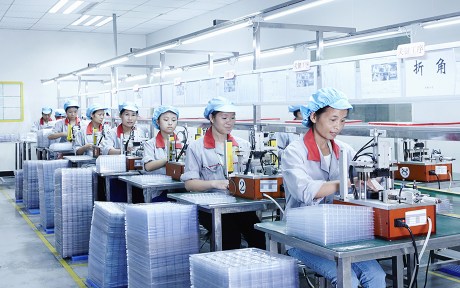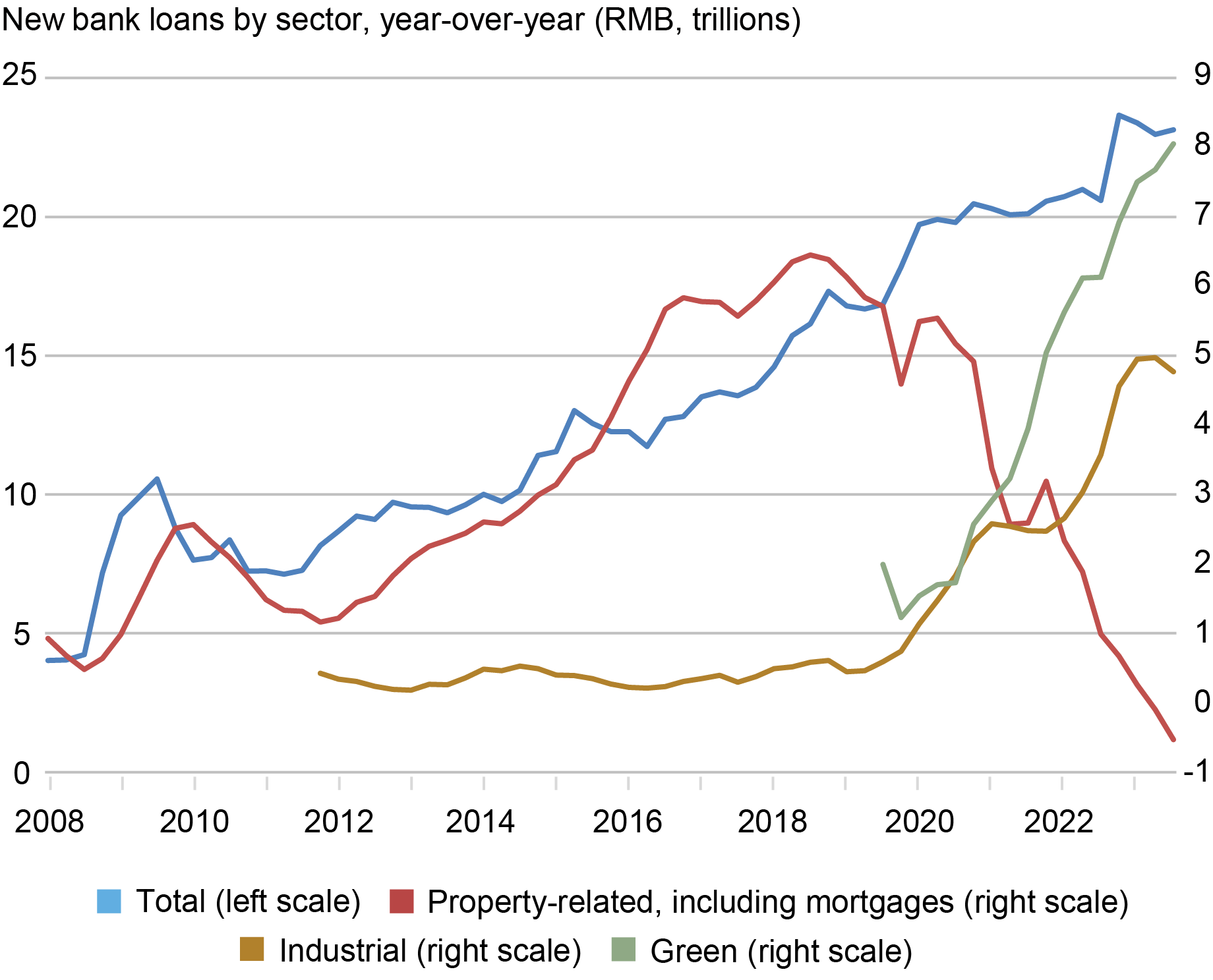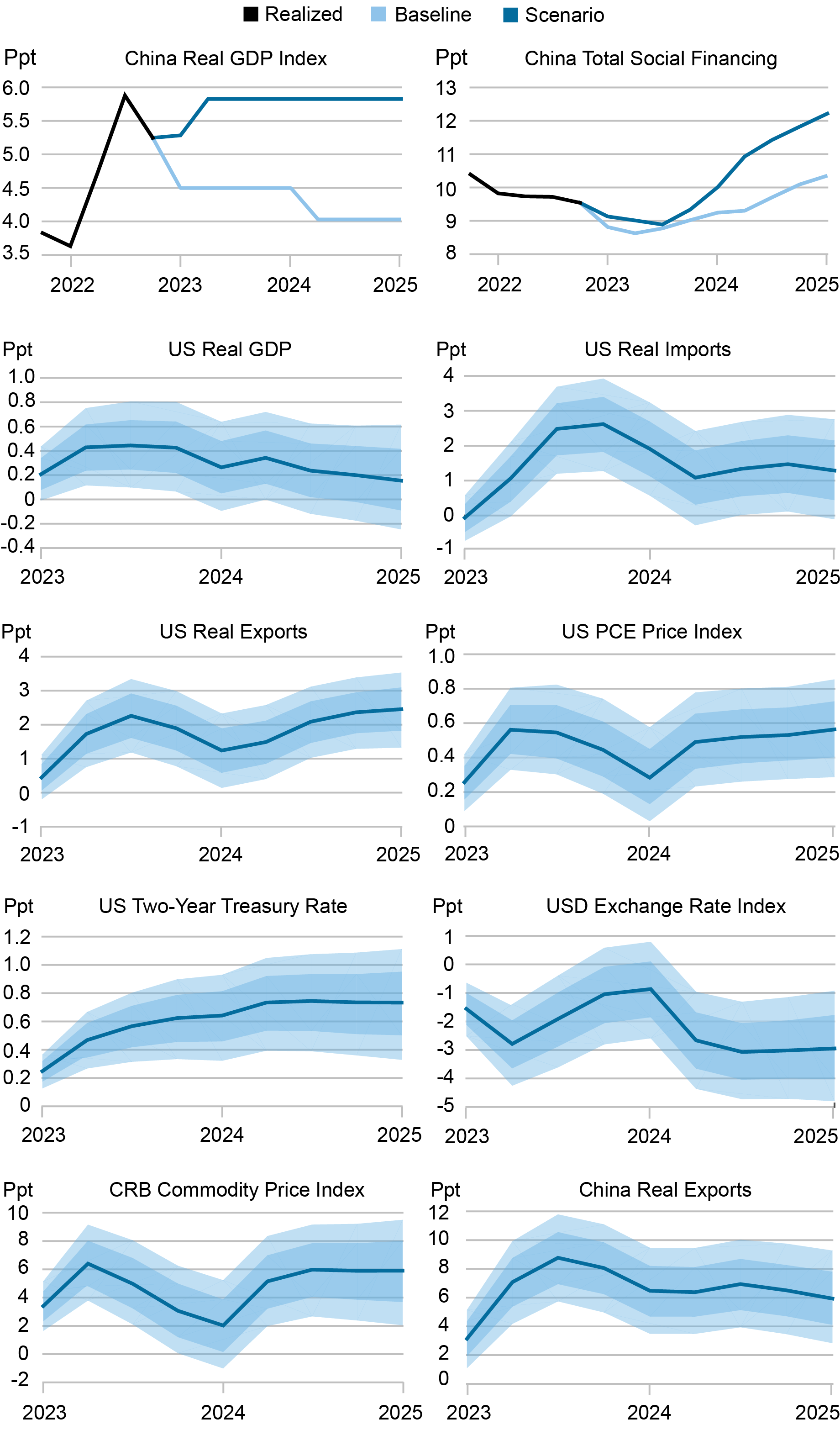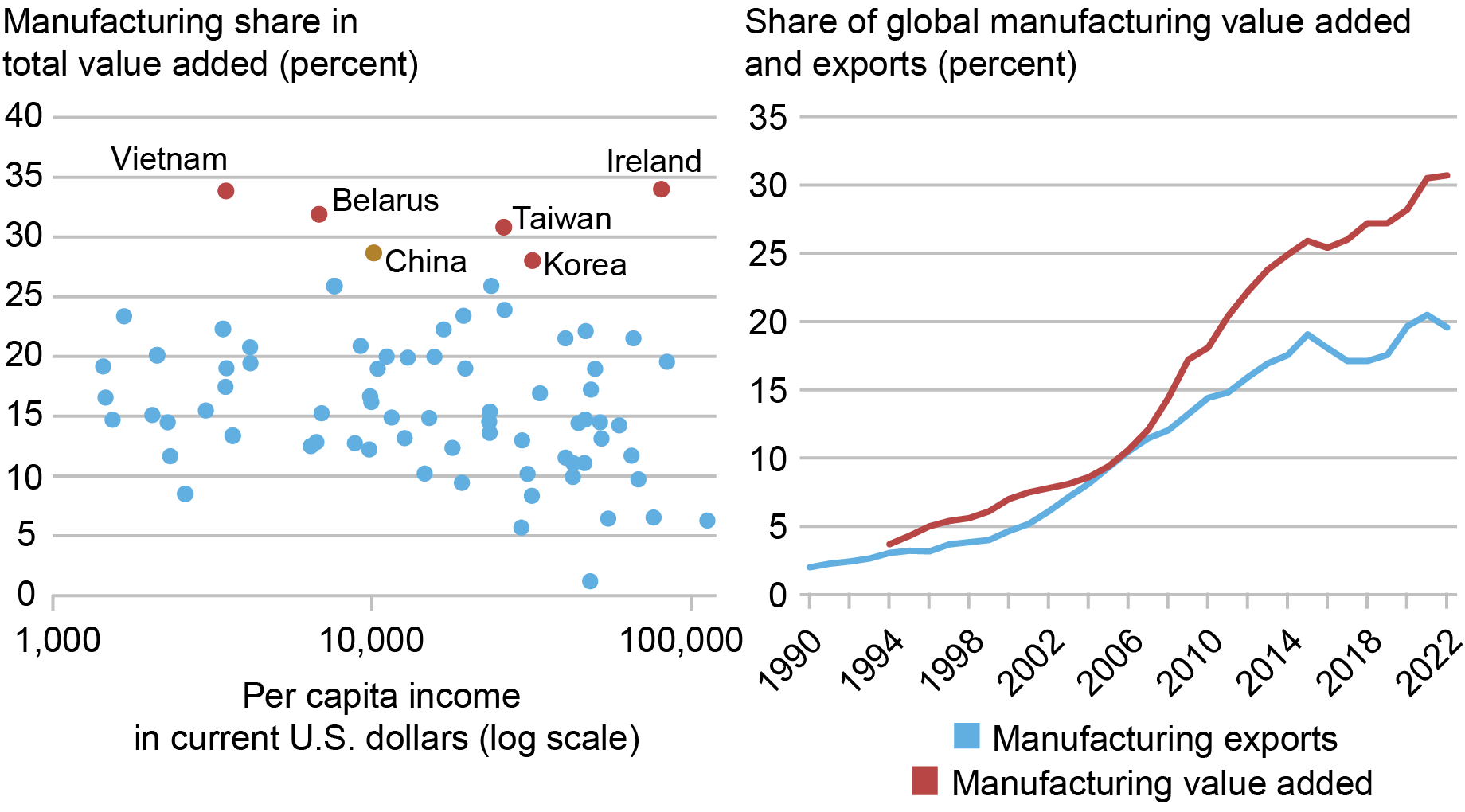
Whereas the stoop in China’s property sector has been steep, Chinese language policymakers have responded to the falloff in property exercise with insurance policies designed to spur exercise within the manufacturing sector. The obvious hope is {that a} pivot towards production-intensive development may help carry the Chinese language economic system out of its present doldrums, which embrace weak family demand, excessive ranges of debt, and demographic and political headwinds to development. In a sequence of posts, we contemplate the implications of two different Chinese language coverage situations for the dangers to the U.S. outlook for actual exercise and inflation over the following two years. Right here, we contemplate the affect of a situation wherein a credit-fueled increase in manufacturing exercise produces higher-than-expected financial development in China. A key discovering is that such a increase would put significant upward stress on U.S. inflation.
A Surge in Financial institution Lending to Manufacturing
The shift in China’s coverage focus is obvious in latest credit score developments. Whereas combination financial institution lending development has remained comparatively steady, lending has been redirected from the property sector and towards the manufacturing sector. Certainly, as proven within the chart beneath, the expansion price for brand new industrial lending has roughly quintupled since 2020 and has doubled in simply the final eighteen months. Progress in new “inexperienced loans”—which overlap with different sectors however are closely concentrated in manufacturing—has picked up much more dramatically. Progress in new lending for property-related exercise, in the meantime, has fallen to close zero.
A Notable Rotation in Credit score Allocation

Word: China’s classification of “inexperienced” overlaps with different sectors. It’s proven for illustrative functions.
To make certain, official credit score knowledge by sector and agency in China are restricted and imprecise. For instance, authorities have discontinued credit score knowledge evaluating state-owned enterprises and privately owned companies. Evaluation of publicly listed Chinese language banks’ quarterly studies, nonetheless, additionally reveals a notable improve in lending to the manufacturing sector over the previous eighteen months. In accordance with knowledge from fifty publicly listed Chinese language banks (accounting for roughly three-quarters of combination credit score), development in financial institution lending to manufacturing got here to 18 % year-over-year in 2022. The info in hand for 2023 counsel new manufacturing lending may have accounted for one-third of complete lending final 12 months. Non-public fairness and enterprise capital funding developments in China mirror this shift.
The redirection in lending comes on high of present monetary incentives for high-tech manufacturing industries, together with electrical automobiles, lithium batteries, photo voltaic panels, and semiconductors. In some instances, these incentives have just lately been sweetened. Final September, for instance, authorities introduced the creation of a brand new state-backed funding fund to spice up growth of the semiconductor sector. And whereas buy subsidies for electrical automobiles had been phased out on the finish of 2022, tax exemptions on each the acquisition and manufacturing facet have been retained.
The redirection in lending can be according to a notable shift within the Chinese language management’s official rhetoric on industrial coverage, which now emphasizes the pursuit of economies of each scope and scale. For strategic as a lot as financial causes, China’s authorities goals to maintain all features of the worth chain in China, preserving and enhancing competitiveness in a variety of industries, not simply specializing in probably the most worthwhile ones. In President Xi’s phrases on the Might 2023 assembly of the Central Fee on Financial and Monetary Affairs, the commercial system must be “full, superior, and safe.”
An Upside State of affairs for Progress in China and Its Implications for the U.S.
We now contemplate the implications of a situation wherein the state-directed credit score help for the manufacturing sector is profitable in reviving China’s near-term financial fortunes, producing a interval of above-trend, production-intensive development. Beneath the situation, China’s GDP development will increase to six % over the following two years, up from formally reported development of 5.2 % in 2023 and 4.9 % in 2022. Progress below the situation additionally exceeds the Worldwide Financial Fund (IMF) baseline, which requires GDP development of 4.6 % in 2024 and 4.0 % in 2025. As we focus on beneath, we consider any interval of manufacturing-led development would show unsustainable over the medium time period—thus our characterization of the situation as involving a “sugar excessive.”
We assess the implications of the situation for the U.S. by evaluating it with the IMF baseline. The important thing assumptions for calibration of the situation contain the connection between GDP development and combination credit score development. We measure combination credit score development by complete social financing (TSF), a broad measure of lending that features shadow finance. (Our measure of TSF differs from China’s official measure by adjusting for native authorities bond redemptions and stripping out fairness issuance, mortgage write-offs, and central authorities bonds.) Utilizing our combination credit score measure, we are able to calculate an implied “credit score impulse,” the move of latest credit score relative to GDP. This permits us to gauge the enhance to development according to the assumed scale of official financial and quasi-fiscal stimulus. Given our calibration, combination credit score development would wish to rise to 12 % over the following two years from the latest 9.5 % to generate the sugar excessive development path. This generates an outsized rise within the related credit score impulse, totaling about 7 1/2 proportion factors.
To quantify the implications of the sugar excessive situation for the U.S. outlook, we depend on a Bayesian vector autoregression (VAR) that features each Chinese language and U.S. macro aggregates. Given the historic relationships amongst these variables, the VAR permits us to generate conditional paths for the variables of curiosity according to the sugar excessive and IMF baseline paths for GDP and TSF (the highest two panels within the chart beneath). The distinction between the projected conditional paths below the 2 simulations offers our measure of sugar excessive impacts. The outcomes are reported in year-on-year proportion development charges, along with related error bands (the underside eight panels within the chart beneath).
A “Sugar Excessive” State of affairs May Generate Persistently Increased Inflation within the U.S.

It’s price stressing that the IMF baseline projection already assumes a moderately optimistic outlook. Certainly, our VAR estimates indicate {that a} 2 1/2 proportion level improve within the credit score impulse from its 2023 degree can be wanted to generate development at this tempo.
Our train reveals that the materialization of this upside situation may generate persistently larger inflation within the U.S. over the following two years. This implication owes to the significance of the Chinese language economic system in world manufacturing. (China accounts for some 30 % of worldwide manufacturing worth added and an excellent bigger share of intermediate manufacturing.) The enhance in Chinese language demand generates larger demand for international items, together with each closing items and intermediate inputs. This pushes up U.S. exports whereas producing important upward stress on world commodity and intermediate items costs. Absent new restrictions on worldwide commerce, Chinese language exports improve persistently and considerably, including to the rise in world commerce volumes. The enhance to commodity costs and world commerce volumes is accompanied by a weakening of the U.S. greenback.
These components—larger commodity and intermediate items costs along with a weaker greenback—contribute to elevated U.S. producer worth inflation. This in flip results in larger PCE inflation, which below our calibration stays persistently above the IMF development baseline by about 0.5 proportion level. This discovering is at odds with the obvious typical knowledge, which holds {that a} manufacturing-led enlargement in China can be disinflationary for the U.S. To make certain, a rise within the provide of Chinese language manufactures would are likely to decrease costs for these items. However this reasoning ignores the pressures that elevated Chinese language manufacturing would place on world commodity markets and the broader manufacturing provide chain. Our estimates and calibration indicate that, primarily based on historic comovements, these upward pressures would dominate.
The affect on U.S. GDP development would even be constructive, however it will be considerably smaller and would fade extra shortly. In brief, the materialization of the sugar excessive situation would persistently tilt the steadiness of dangers for U.S. inflation to the upside. On the present juncture, such an impetus to inflation may doubtlessly delay market expectations for coverage easing.
Limits to Sustained Manufacturing-Led Progress
A producing sugar excessive represents a believable account of how China’s development would possibly exceed consensus expectations within the close to time period. (This assumes after all that the authorities reach stabilizing the property sector.) However redoubled coverage help for manufacturing is unlikely to supply the proper vitamin for longer-term growth. China’s economic system is already closely manufacturing oriented, with the share of producing in GDP at 28 %, above the worldwide ninety fifth percentile, as illustrated on the left panel of the chart beneath. Given the nation’s measurement, this interprets into an already outsized presence within the world manufacturing ecosystem, at some 30 % of worldwide manufacturing output and 20 % of worldwide exports (proper panel of the chart). Most necessary, the purpose of sustaining a “full” manufacturing ecosystem quantities to a dedication to subsidize low-return, labor-intensive industries the place China now not enjoys a comparative benefit. The danger for China is {that a} sustained deal with manufacturing will result in low returns and a brand new cycle of unhealthy debt.
China: Massive and In Cost

Word: Knowledge in left panel confer with 2019.
The scope for manufacturing-led development may also be restricted by buying and selling companions’ willingness to soak up a brand new flood of Chinese language merchandise. On this connection, China’s manufacturing commerce surplus now stands at an enormous $1.6 trillion, greater than 10 % of GDP. Complaints that China is dumping extra capability on the remainder of the world have been a commonplace in world coverage debates, stretching from metal within the 2000s to photo voltaic panels, autos, and lithium batteries extra just lately. Continued development in China’s manufacturing commerce surplus would probably speed up buying and selling companions’ efforts to guard native markets. Notably, our sugar excessive situation assumes that there might be no new restrictions over the close to time period.

Ozge Akinci is head of Worldwide Research within the Federal Reserve Financial institution of New York’s Analysis and Statistics Group.

Hunter L. Clark is a global coverage advisor in Worldwide Research within the Federal Reserve Financial institution of New York’s Analysis and Statistics Group.

Jeffrey B. Dawson is a global coverage advisor in Worldwide Research within the Federal Reserve Financial institution of New York’s Analysis and Statistics Group.

Matthew Higgins is an financial analysis advisor in Worldwide Research within the Federal Reserve Financial institution of New York’s Analysis and Statistics Group.

Silvia Miranda-Agrippino is a analysis economist in Worldwide Research within the Federal Reserve Financial institution of New York’s Analysis and Statistics Group.

Ethan Nourbash is a analysis analyst within the Federal Reserve Financial institution of New York’s Analysis and Statistics Group.

Ramya Nallamotu is a analysis analyst within the Federal Reserve Financial institution of New York’s Analysis and Statistics Group.
Find out how to cite this publish:
Ozge Akinci, Hunter Clark, Jeff Dawson, Matthew Higgins, Silvia Miranda-Agrippino, Ethan Nourbash, and Ramya Nallamotu, “What if China Manufactures a Sugar Excessive?,” Federal Reserve Financial institution of New York Liberty Road Economics, March 25, 2024, https://libertystreeteconomics.newyorkfed.org/2024/03/what-if-china-manufactures-a-sugar-high/.
Disclaimer
The views expressed on this publish are these of the creator(s) and don’t essentially mirror the place of the Federal Reserve Financial institution of New York or the Federal Reserve System. Any errors or omissions are the duty of the creator(s).

